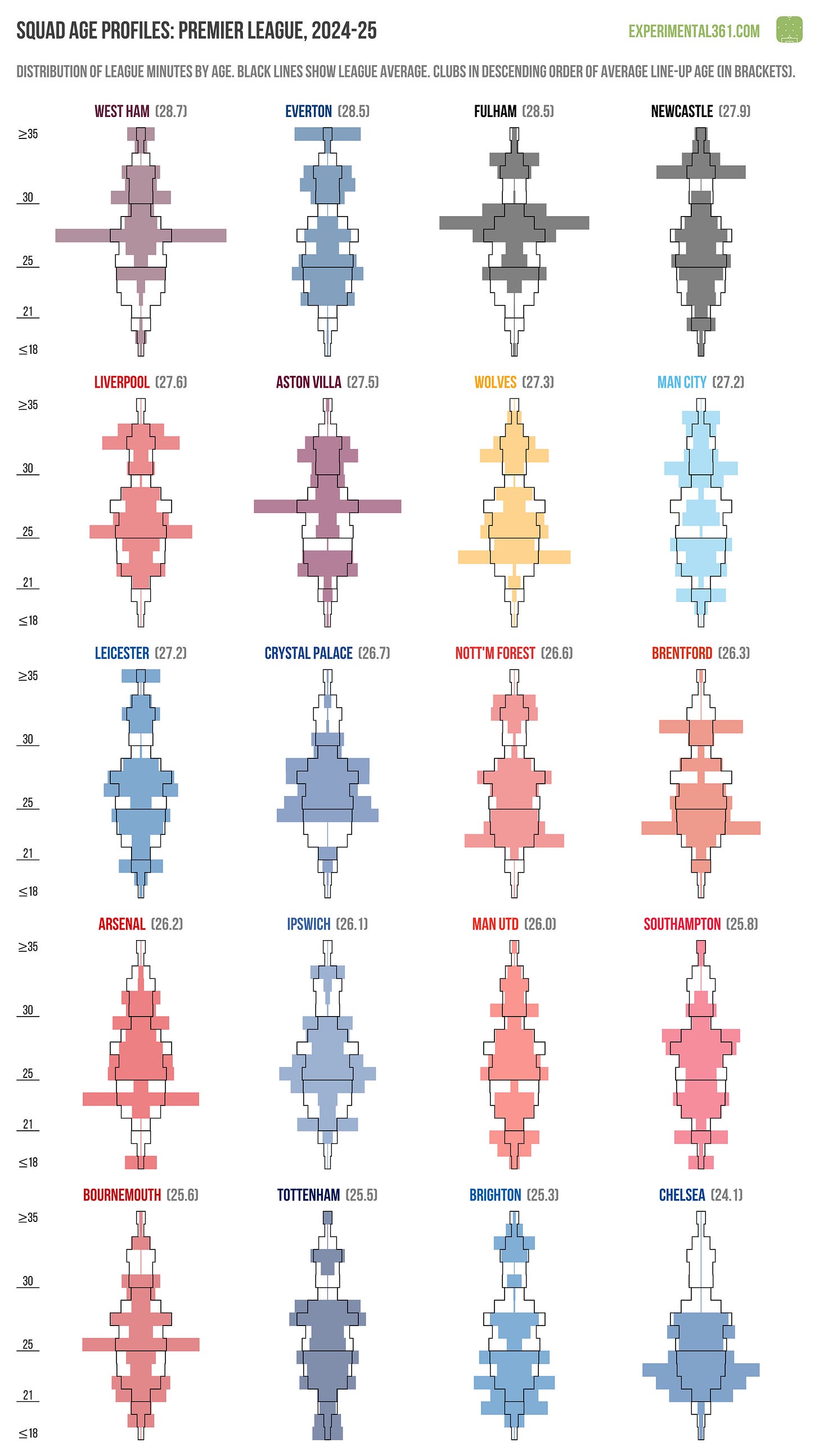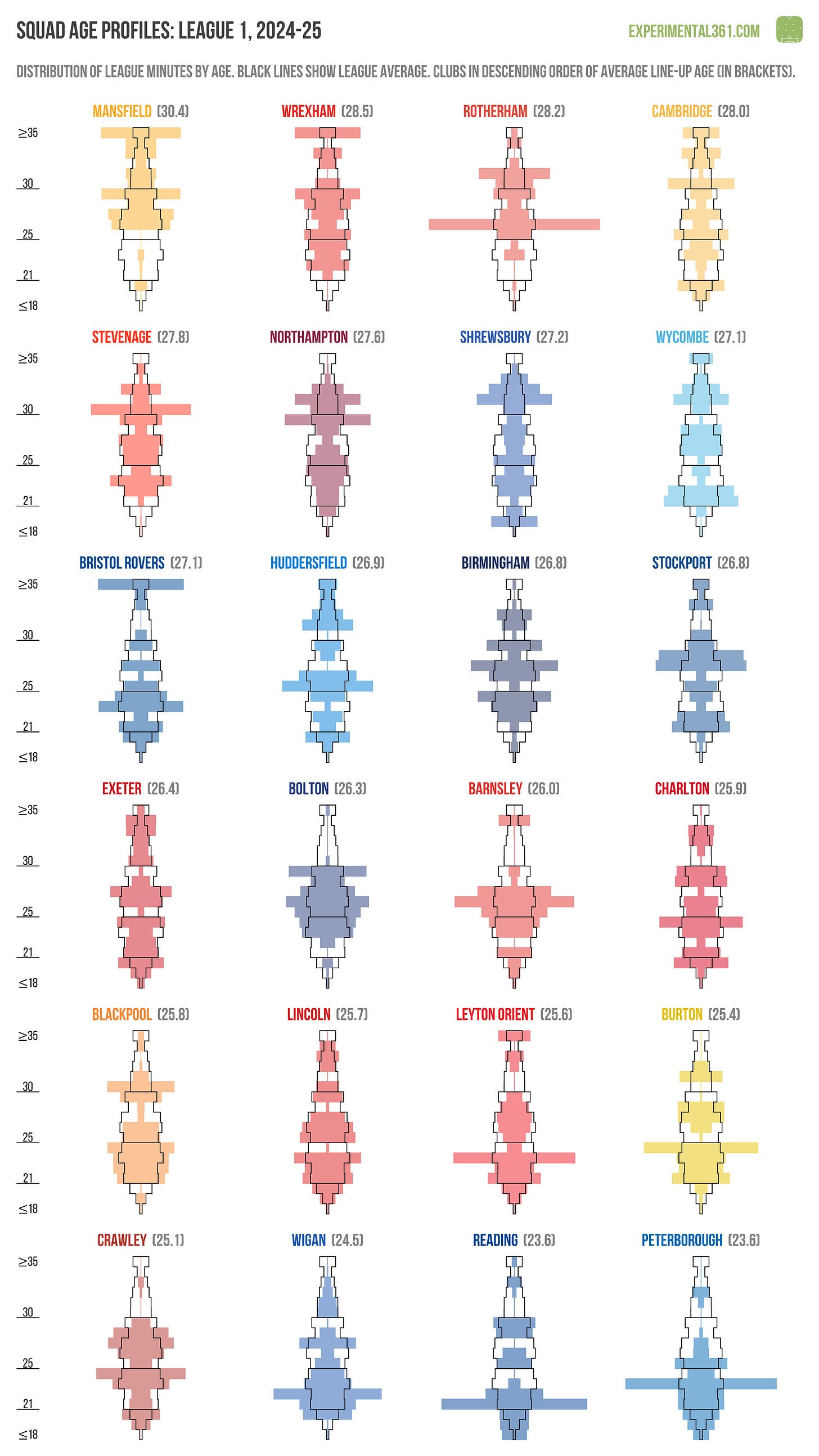Squad age profiles, 2024-25
Iterating a classic visualisation
After a slow start to 2025, not only have I finally published something but also found time to give it a bit of a makeover.
For each club in the top four English divisions I’ve created a little “population pyramid” to summarise the share of minutes they gave to players of each age. These are calculated using everyone’s exact ages at the time of each match.
I find these useful in getting a sense of how balanced each squad was and also which clubs put more trust in youth during the season.
Here’s a quick example of how they work using Cardiff, as they had one of the more interesting profiles.
Starting with the label at the top, the number in brackets is the average age of their starting line-ups in years.
Age increases as you go up the diagram, so we have the share of minutes given to players aged 18 (and under) at the bottom, then 19-year-olds etc all the way up to a bucket for everyone aged 35 or older. The black hollow shape is the average distribution for the league this season, with a few horizontal lines to indicate age boundaries. The coloured area is that club’s distribution, so we can see how it differs.
In Cardiff’s case, their use of young players overall this season was pretty average, with 22-year-olds getting quite a few minutes. However, they didn’t use that many peak-aged players (i.e. those in their prime years), instead relying on players aged 29-31. Their four most-used outfielders are all now in their thirties: O'Dowda, Chambers, Goutas and Ng.
That’s not necessarily a problem, as players of this age are hardly decrepit, but there’s a good chance they’re past their physical peak. Therefore if the club were to take the same squad into next season then there’s a chance of that elder core not being able to cover as much ground or contribute as many minutes.
Let’s now look at all of the 92 clubs, league-by-league.
Premier League
Starting in the top flight, Chelsea immediately stand out with their extreme focus on youth. Their starting line-ups were over a year younger than anyone else’s on average: a shade over 24, with their most youthful XI of the season being almost a full year younger than that. They were also the only team out of the 92 not to field anyone over the age of 27 in a league game.
Meanwhile Crystal Palace’s successful season was built around peak-aged players, with very little playing time given to anyone under 24 or over 30. While the younger members of that cohort still have plenty of good years ahead of them, it may be prudent to give some emerging talents a bit more first-team exposure next season.
Championship
Moving onto the second tier, it’s another young team that catches the eye: Sunderland got promoted with the Championship’s lowest average starting age. Nobody in the top four English divisions gave a higher share of minutes to teenagers than their 22%, with Jobe Bellingham, Chris Rigg and Eliezer Mayenda all regular starters.
At the other end of the spectrum, Blackburn were another team who relied heavily on peak-aged players this season while giving more minutes to over-32s than under-25s.
League One
England’s third tier had the biggest spread of ages, including both the oldest and youngest teams in the top four divisions.
Starting with the oldest, Mansfield’s starting line-ups were the only ones to clock in at over 30 on average. Almost half of league minutes (45%) went to players in their thirties and their final XI of the season had an average age of almost 32: it featured six starters aged between 33 and 39, with a 35-year-old Jordan Rhodes coming off the bench.
At the youthful end of the spectrum, there were only 20 days separating the average ages of Reading and Peterborough’s starting line-ups. While the Royals were one of only two teams covered here who gave more than half of their minutes to players aged 21 and under, a few regular starters in their late twenties (Lewis Wing and Joel Pereira) bumped up their overall average.
League Two
Finally in the fourth tier, Crewe were the other team for whom players aged 21 or under accumulated half of all league minutes. All of their four most regular starters -Filip Marshall (who recently turned 22), Max Conway, Zac Williams and Joel Tabiner - were in this category. However, this wasn’t entirely down to their academy as the first two players in that list were loanees.
Walsall made it to the play-off final with a youthful team augmented by a few experienced heads (35-year-old Jamille Matt and 37-year-old Albert Adomah). Meanwhile Bromley and Salford look to have navigated this season with a blend of youth and experience but not much in between.








I'm not entirely sure how useful this tool is for deciding whether 'squad balance' is a good thing or not when it comes to age? Luton & Leicester looked to have a very balanced squads on your diagrams (covering all age bases), they both had disastrous seasons, Chelsea very young, erratic in the league but won the club world cup (Walsall similarly young started strong and fell off) think there is certainly a trend in the younger teams underperforming (due to lack of experience), I think the sweet spot is certainly around the 27 mark for getting it right, the mix of experience and youth often provides good balance of head and legs (knowhow), interesting Mansfield at their season at the level went for experience, which in the end was the tool which kept them safe. Nice drawings and gives good insight how each club operated last season.